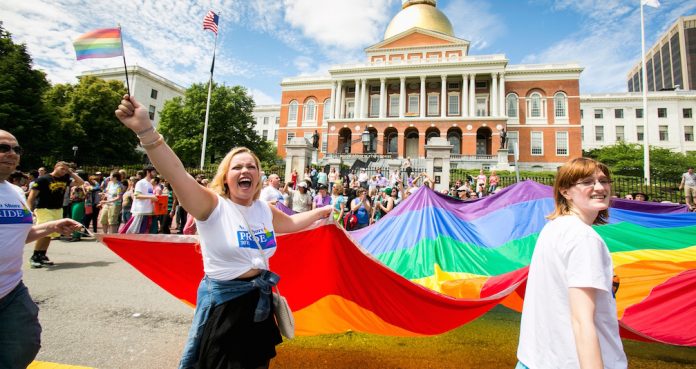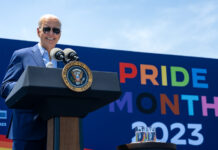
Today’s young people feel significantly free to identify as LGBT in Massachusetts—nearly 16 percent for those ages 18 to 25 and more than 10 percent for those 25 to 34, according to a recently released study by the Boston Foundation and the Fenway Institute.
The two nonprofits used public data, private research and personal interviews to do the research for this groundbreaking study, “Equality and Equity: Advancing the LGBT community in Massachusetts.” Previously data from such surveys had only been reported in academic settings.
“[The information] hasn’t really been presented to a broad array of audiences,” Sean Cahill, director of health policy research at the Fenway Institute, told the Boston Globe for a May 24 article. “So we thought it would be interesting to just say, ‘What do we know about the LGBT community demographic?’ and ‘What are some of the issues facing the community?'”
The Globe goes on to report that:
[Massachusetts] was found to be the second “gayest in the country,” after Vermont, according to researchers.
Of residents ages 18 to 24, nearly 16 percent consider themselves LGBT, while more than 10 percent of people age 25 to 34 self-identify as such, according to the report titled “Equality and Equity: Advancing the LGBT community in Massachusetts.”
Conversely, less than 3 percent of residents ages 65 to 74 self-identify as LGBT, according to the report, though it’s worth noting that 92 percent of American LGBT adults say “society has become more accepting of them in the past decade.”
One observer said that aside from a changing social climate, the ability to find information about LGBT issues has helped more young people disclose their gender identity or sexual orientation.
“I think younger generations have more access to information in understanding our identities as LGBTQ-plus,” said Mason Dunn, executive director of the Massachusetts Transgender Political Coalition. “[When] we have a better understanding of who we are and who we know ourselves to be, we can therefore can come out at younger ages than some of the folks who are learning the terminology and coming to realizations later in life.”
Researchers hope the report helps to educate the public about the state’s LGBT community. …
Still, despite such progress, LGBT people still deal with rampant discrimination. The reality is even more stark for transgender people and people of color at work, home, and in public, the report states.
LGBT people are “more likely to be targets of hate crimes than any other group in America.”
An estimated 88 percent of LGBT youth of color say they dealt with discrimination in the past year. Anti-LGBT hate crimes tend to be “more violent and result in hospitalization more often than those based on race/ethnicity, religion or disability.”
Dunn noted many members of the LGBT community, particularly if they are people of color, often face a “really hostile environment.”
“If we are really working for LGBT-plus equality, that also means we are working for racial equality and an end to racism,” he said.
The community also faces major economic hurdles.
Lesbian, gay, bisexual, and transgender high schoolers are more likely to experience homelessness than their non-LGBT peers, and a 2014 study conducted by the Fenway Institute found that 32.7 percent of LGBT youth of color in Greater Boston were unemployed, 15.5 percent were unstably housed, and 30.9 percent were food insecure, according to the report.
“A lot of the unfinished business with our community are really more like equity issues,” Cahill said. “Just the cost of living in Boston is a huge issue. . . . When people think of the gay community, they don’t always think of economic hardship, but that is a major issue.”
Grace Sterling Stowell, executive director of the Boston Alliance of Lesbian, Gay, Bisexual, Transgender, Queer Youth, said the report’s findings validated what she already knew after 40 years of working with young people and in transgender advocacy.
Transgender residents experience higher rates of poverty, and 61 percent of transgender people experience housing discrimination, according to the report.
“Despite the great strides we’ve achieved in Massachusetts over decades,” she said, “the data demonstrates that we have a ways to go.”
Emotional issues are also a concern for LGBT residents of all ages.
Nearly half of young people who self-identify as LGBT have contemplated suicide, compared with 11 percent of youth who do not identify as LGBT, researchers found.
An estimated 35 percent “had devised a plan, and 25 percent of LGBT youth say they had attempted suicide, five times the rate of non-LGBT youth,” according to the report.
There are similar challenges for older generations. Almost one-third of 33 percent of LGBT adults ages 50 to 75 have been diagnosed with depression, the report said.
To be sure, there are bright spots in the state to address LGBT issues, Cahill said.
“We have some really great public policies and really great social services for the LGBT community in Massachusetts,” Cahill said. “We’re really innovative and we have things that most other states don’t offer people, so we wanted to highlight that, too.”








